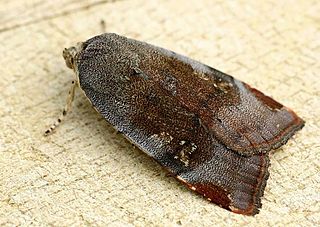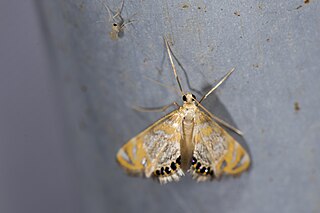
The Noctuidae, commonly known as owlet moths, cutworms or armyworms, are a family of moths. They are considered the most controversial family in the superfamily Noctuoidea because many of the clades are constantly changing, along with the other families of the Noctuoidea. It was considered the largest family in Lepidoptera for a long time, but after regrouping Lymantriinae, Catocalinae and Calpinae within the family Erebidae, the latter holds this title now. Currently, Noctuidae is the second largest family in Noctuoidea, with about 1,089 genera and 11,772 species. This classification is still contingent, as more changes continue to appear between Noctuidae and Erebidae.

The large yellow underwing is a moth, the type species for the family Noctuidae. It is an abundant species throughout the Palearctic realm, one of the most common and most familiar moths of the region. In some years the species is highly migratory with large numbers appearing suddenly in marginal parts of the range.

The lesser yellow underwing is a moth of the family Noctuidae.

The lesser broad-bordered yellow underwing or Langmaid's yellow underwing is a moth of the family Noctuidae. It is distributed throughout southern and central Europe, and southern Sweden.

Catocala is a generally Holarctic genus of moths in the family Erebidae. The genus was erected by Franz von Paula Schrank in 1802. The moths are commonly known as underwing moths or simply underwings. These terms are sometimes used for a few related moths, but usually – especially when used in plural, not as part of a species name – they are used to refer to Catocala only.

Noctua is a genus of moths. They have dull, cryptic forewings and often very bright hindwings. These are hidden under the forewings when the moths rest, leading to their common name of yellow underwings. They are not particularly closely related to the "true" underwing moths (Catocala) though, apart from both being Noctuoidea. They are good fliers.

Noctua janthe, the lesser broad-bordered yellow underwing, is a moth of the family Noctuoidea. Some authors consider Noctua janthe and Noctua janthina to be the same species. It is found in Europe and North Africa.

Noctua interjecta, the least yellow underwing, is a species of moth of the family Noctuidae. It is found in Europe.

Noctua fimbriata, the broad-bordered yellow underwing, is a moth of the family Noctuidae. It is found in Europe, North Africa, Anatolia, the Caucasus, Turkey, Caucasus, Transcaucasia, Armenia, Turkmenistan and Novosibirsk Oblast. The border of its southern range is unclear because of the similar looking species Noctua tirrenica.

Noctua orbona, the lunar yellow underwing, is a moth of the family Noctuoidea. It is found in the Palearctic.

Eoophyla is a genus of moths of the family Crambidae. It was erected by Charles Swinhoe in 1900.
Margarosticha is a genus of moths of the family Crambidae.

Nymphicula is a genus of moths of the family Crambidae.

Paracymoriza is a genus of moths of the family Crambidae.

Parapoynx is a genus of moths of the family Crambidae described by Jacob Hübner in 1825.

The moth skink is a species of skink. It is found in Pacific regions including Sulawesi, Northern Papua New Guinea, Solomon Islands, Vanuatu, Tuamotu, Marquesas Islands, Pitcairn Islands, Hawaii, Indonesia, Fiji, Western Samoa, Admiralty Islands, Bismarck Archipelago, Tonga, Toga, Tegua, Cook Islands and Guam.














